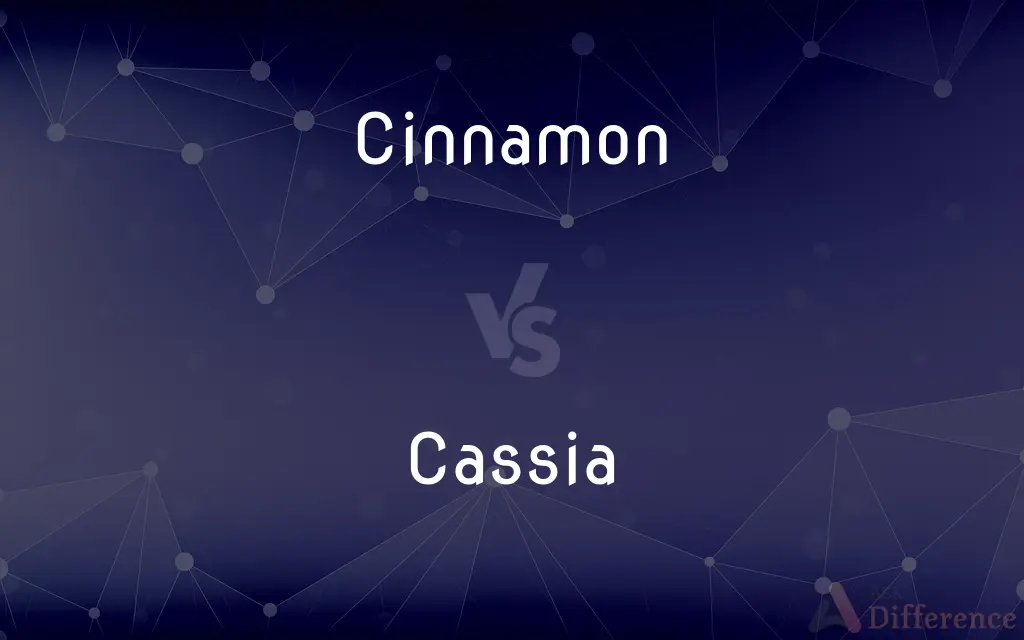Cinnamon vs. Cassia — What's the Difference?
By Fiza Rafique & Maham Liaqat — Updated on March 24, 2024
Cinnamon and cassia are both spices derived from the bark of trees in the Cinnamomum genus, but true cinnamon (Ceylon cinnamon) has a sweeter, more delicate flavor compared to the stronger, more pungent taste of cassia.

Difference Between Cinnamon and Cassia
Table of Contents
ADVERTISEMENT
Key Differences
Cinnamon, often referred to as true cinnamon or Ceylon cinnamon, comes from the Cinnamomum verum tree, native to Sri Lanka and parts of India and Madagascar. Cassia, on the other hand, is often referred to as Chinese cinnamon or Saigon cinnamon, derived from several Cinnamomum species, including Cinnamomum aromaticum and Cinnamomum cassia.
Nutritionally, both cinnamon and cassia contain health-beneficial compounds, including antioxidants. However, cassia contains higher levels of coumarin, a compound that can be harmful in large quantities, leading to the recommendation of consuming Ceylon cinnamon for those who use cinnamon regularly in large amounts.
The distinction between cinnamon and cassia is more pronounced in the culinary world than in general commerce, where the term "cinnamon" is often used to describe both spices. Despite their differences, both spices are used to flavor a variety of foods, from sweet to savory dishes, and have been valued for their medicinal properties for centuries.
True cinnamon sticks are characterized by their thin, multi-layered bark, which is lighter in color and easier to grind. Cassia is more common in the United States and Canada, largely due to its lower price and more potent flavor.
Comparison Chart
Origin
Sri Lanka, India, Madagascar
China, Indonesia, Vietnam
ADVERTISEMENT
Flavor
Sweet, delicate, and complex
Strong, pungent, and slightly bitter
Bark Appearance
Thin, multi-layered, light brown
Thick, single layer, darker
Preferred Use
Desserts, sweet dishes
Savory dishes, baking
Coumarin Content
Low, safer for regular consumption
High, can be harmful in large doses
Price
Generally more expensive
Less expensive, more widely available
Grinding
Easier to grind due to softer bark
Harder to grind
Compare with Definitions
Cinnamon
Low in coumarin, making it preferable for regular use.
For health-conscious consumers, Ceylon cinnamon is the recommended choice.
Cassia
Commonly used in American kitchens and products.
The cinnamon used in many American cinnamon rolls is actually cassia.
Cinnamon
More expensive and considered gourmet.
Gourmet chefs prefer Ceylon cinnamon for its aromatic and complex flavors.
Cassia
A robust, pungent spice from various Cinnamomum species.
Cassia adds a strong flavor to Chinese five-spice powder.
Cinnamon
A delicate and sweet spice from the Cinnamomum verum tree.
Ceylon cinnamon is often used in fine pastries and desserts.
Cassia
Has a thick, darker bark that is hard to grind.
The single-layered bark of cassia is often sold in sturdy sticks.
Cinnamon
Preferred in European cuisine for its subtle flavor.
Traditional Mexican mole recipes call for Ceylon cinnamon for its unique taste.
Cassia
Contains higher levels of coumarin.
Due to its coumarin content, cassia consumption should be moderated.
Cinnamon
Characterized by thin, multi-layered bark.
The light, fragile bark of Ceylon cinnamon easily crumbles into powder.
Cassia
Less expensive and widely available.
Cassia is often found in supermarkets due to its affordability and strong flavor.
Cinnamon
Cinnamon is a spice obtained from the inner bark of several tree species from the genus Cinnamomum. Cinnamon is used mainly as an aromatic condiment and flavouring additive in a wide variety of cuisines, sweet and savoury dishes, breakfast cereals, snackfoods, tea and traditional foods.
Cassia
Any of various chiefly tropical or subtropical trees, shrubs, or herbs of the genus Cassia in the pea family, having pinnately compound leaves, usually yellow flowers, and long, flat or cylindrical pods.
Cinnamon
An aromatic spice made from the peeled, dried, and rolled bark of a SE Asian tree
A cinnamon cake
A teaspoon of ground cinnamon
Cassia
A tropical evergreen tree (Cinnamomum aromaticum syn. C. cassia) of East and Southeast Asia, having aromatic inner bark.
Cinnamon
The tree which yields cinnamon.
Cassia
The bark of this tree, often ground and used as a spice. It is the chief source of cinnamon in the United States.
Cinnamon
The dried aromatic inner bark of certain tropical Asian trees of the genus Cinnamomum, especially C. verum and cassia (C. aromaticum), often ground and used as a spice.
Cassia
(uncountable) The spice made from the bark of members of the genus Cinnamomum other than true cinnamon (C. verum), when they are distinguished from cinnamon.
Cinnamon
A tree yielding this bark.
Cassia
(countable) Such trees themselves, particularly the Chinese cinnamon, Cinnamomum cassia.
Cinnamon
A light reddish brown.
Cassia
(countable) Any of several tropical leguminous plants, of the genus Cassia.
Cinnamon
Flavored with cinnamon.
Cassia
(countable) Any of several tropical leguminous plants, of the genus Senna.
Cinnamon
Of a light reddish brown.
Cassia
(countable, mistranslation from Chinese) The sweet osmanthus (O. fragrans).
Cinnamon
(countable) A small evergreen tree native to Sri Lanka and southern India, Cinnamomum verum or Cinnamomum zeylanicum, belonging to the family Lauraceae.
Cassia
A genus of leguminous plants (herbs, shrubs, or trees) of many species, most of which have purgative qualities. The leaves of several species furnish the senna used in medicine.
Cinnamon
Several related trees, notably the Indonesian cinnamon (Cinnamomum burmanni) and Chinese cinnamon or cassia (Cinnamomum aromaticum or Cinnamomum cassia).
Cassia
The bark of several species of Cinnamomum grown in China, etc.; Chinese cinnamon. It is imported as cassia, but commonly sold as cinnamon, from which it differs more or less in strength and flavor, and the amount of outer bark attached.
Cinnamon
A spice from the dried aromatic bark of the cinnamon tree, either rolled into strips or ground into a powder. The word is commonly used as trade name for spices made of any of the species above.
Cassia
Any of various trees or shrubs of the genus Cassia having pinnately compound leaves and usually yellow flowers followed by long seedpods
Cinnamon
, the product made of Cinnamomum verum
Cassia
Chinese tree with aromatic bark; yields a less desirable cinnamon than Ceylon cinnamon
Cinnamon
(countable) A warm yellowish-brown color, the color of cinnamon.
Cinnamon
Containing cinnamon, or having a cinnamon taste.
Cinnamon
Of a yellowish-brown color.
Cinnamon
The inner bark of the shoots of Cinnamomum Zeylanicum, a tree growing in Ceylon. It is aromatic, of a moderately pungent taste, and is one of the best cordial, carminative, and restorative spices.
Cinnamon
Aromatic bark used as a spice
Cinnamon
Tropical Asian tree with aromatic yellowish-brown bark; source of the spice cinnamon
Cinnamon
Spice from the dried aromatic bark of the Ceylon cinnamon tree; used as rolled strips or ground
Common Curiosities
Can I substitute cassia for cinnamon in recipes?
Yes, but cassia has a stronger flavor, so you may want to use less to avoid overpowering the dish.
Why do some cuisines prefer Ceylon cinnamon while others use cassia?
It depends on the flavor profile of the cuisine; sweeter dishes tend to use Ceylon for its delicate taste, while cassia is used for its robust flavor in spicier dishes.
Why is Ceylon cinnamon considered healthier?
It has lower levels of coumarin, which is safer for regular, high consumption.
Is there a significant price difference between the two?
Yes, Ceylon cinnamon is generally more expensive due to its lower yield and more delicate flavor.
How can I distinguish between Ceylon cinnamon and cassia at the store?
Look at the bark; Ceylon cinnamon has thin, multi-layered sticks, while cassia sticks are thicker and darker.
Can consuming too much cassia be harmful?
Yes, due to its high coumarin content, excessive consumption of cassia can lead to health issues, particularly affecting liver function.
How should I store cinnamon and cassia to maintain their freshness?
Store in a cool, dark place in airtight containers to protect their flavors and aromatic oils.
Is it worth buying Ceylon cinnamon despite the higher price?
For those sensitive to coumarin or seeking a specific, delicate flavor profile in their dishes, Ceylon cinnamon is worth the investment.
How does the flavor of cassia compare to Ceylon cinnamon in baking?
Cassia's strong flavor makes it suitable for bolder, spicier baked goods, whereas Ceylon's subtlety is preferred in delicate desserts.
Are there any dishes that specifically require Ceylon cinnamon?
Many traditional dishes, particularly from Sri Lanka or Mexico, may specify Ceylon cinnamon for its authentic taste.
Share Your Discovery

Previous Comparison
Smooth vs. Rough
Next Comparison
Earthing vs. GroundingAuthor Spotlight
Written by
Fiza RafiqueFiza Rafique is a skilled content writer at AskDifference.com, where she meticulously refines and enhances written pieces. Drawing from her vast editorial expertise, Fiza ensures clarity, accuracy, and precision in every article. Passionate about language, she continually seeks to elevate the quality of content for readers worldwide.
Co-written by
Maham Liaqat















































